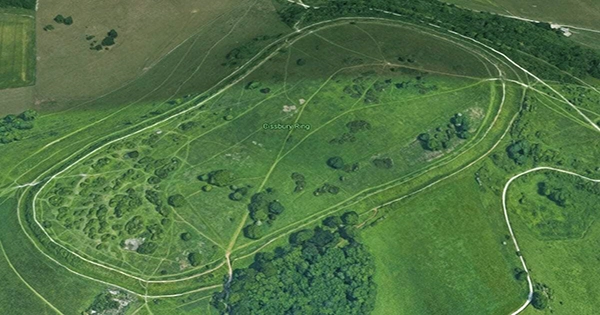Danebury Fort, also known simply as Danebury, is an Iron Age hillfort in the English county of Hampshire. It is notable for its archeological significance and is one of the most thoroughly examined hillforts in Britain. It received more attention and excavation between 1969 and 1988 than any other hill fort in Britain. As a result, historians and archaeologists were able to gain a clear picture of life in an Iron Age hillfort. It was recently linked to the existence of a hitherto unknown Iron Age king, as evidenced by a coin. What do we know about this magnificent historical landmark?
Danebury Fort is in the English county of Hampshire. It’s near the town of Nether Wallop in Hampshire’s southeastern corner, about 19 kilometers (12 miles) northwest of the ancient city of Winchester. The fort’s hilltop location gave strategic benefits such as a commanding view of the surrounding area. Iron Age hill forts were typically erected on such tough terrain, affording them stronger defensive abilities and better territorial control.

It was built during the Iron Age, specifically the Late Iron Age. The exact date of its construction is unknown, however, it is thought to have been built around 500 BC and occupied until the Roman conquest of Britain in the first century AD. Throughout its long history, the fort has been restored and enlarged numerous times. New ditches were excavated, better ramparts were built, and additional dwellings were built. This suggests that Danebury was highly important to its residents and that they had to constantly renovate their homes to make them more comfortable and secure.
This enormous hill fort is distinguished by its circular layout, which is common among British Iron Age hillforts. The fort’s circular shape covers an area of about 5.2 hectares (13 acres). The round shape, earthworks, and ditches were built as defensive measures to defend the people from outside dangers. Circular enclosures are significantly easier to defend than square ones, and they are also easier to maintain and create. Our forefathers were fully aware of this, which is why the design endured for so long.
The Ancient Britons’ Homeland: Danebury Fort is well-known for the significant archaeological digs that have occurred there. Notably, the most extensive excavations were led by acclaimed archaeologist Barry Cunliffe in the 1960s and 1970s. These excavations provided important information about the daily lives and daily activities of the Iron Age people who lived in Danbury. Danebury excavations uncovered a diverse assortment of objects. These comprised ceramics, utensils, jewelry, and other goods used by the residents daily. The relics reveal much about the material culture and technology of the people who lived at Danebury during the Iron Age. And the discoveries were priceless for English archaeology as a whole.
Danebury Fort is thought to have played an important part in Britain’s Late Ages of Iron culture. Its circular architecture and elaborate defenses suggest that it served as a hub for trade, and agriculture, and possibly as a regionally significant location with leadership systems such as a chiefdom or tribe leadership. However, history has forgotten whose tribe inhabited it or what its original name was. Nonetheless, its significance is obvious from its size and defenses.
Danebury, like many other Iron Age hillforts, was abandoned after the Roman conquest of Britain in the first century AD. The precise reasons for its demise are still being debated by academics. Changes in governmental and economic systems, as well as the effects of Romanization, are thought to have contributed to its demise. Keep in mind that the entrance of the Romans wrought havoc on the society of Iron Age Britons. It was an invasion that altered Britain’s social and political environment in a matter of generations.
And, because Danebury is so near to the sea in the south, we might presume it was one of the first hill forts to bear the brunt of Roman attacks.
One of England’s Most Important Archaeological Sites: Historic England manages Danebury Fort, which is a protected archaeological site. It is still an important site for archaeology research and education. The site is open to the public and draws people interested in British Iron Age history. The well-preserved earthworks and a plethora of archeological discoveries make it an important historical and educational resource.
The historical and archaeological relevance of the fort stems from its capacity to provide a window into the life of Iron Age inhabitants in Britain and the role of hillforts in their culture, as well as the changes that happened during the region’s transition to Roman authority.
















